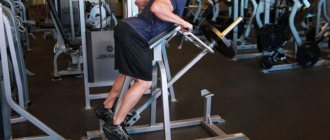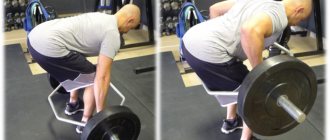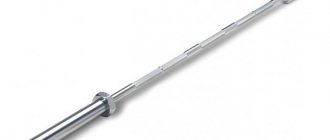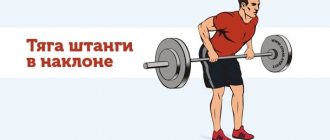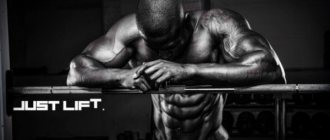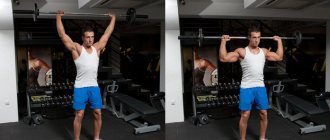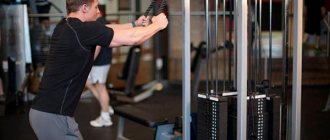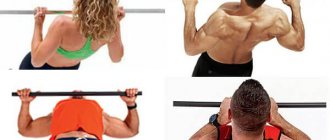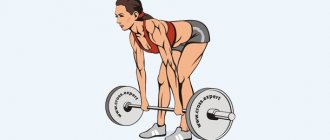The dumbbell row helps correct muscle imbalances and develop your back. By using dumbbells, it is possible to balance muscle development and learn to pull equally on both halves of the back. This is a key movement for a sculpted back, developed lats and harmonious posture. Can be performed both with significant weight and with light dumbbells. The exercise belongs to the heritage of old school bodybuilding, and is performed by many athletes on a regular basis.
Types of pulls and working muscles
Deadlifts differ according to the type of starting position adopted by the athlete:
- Bent over row without support;
- Standing on one knee on the bench;
- With your stomach resting on a bench, horizontal or inclined
The main muscle worked in all types of back rows is the latissimus. The movement also involves the rhomboid, trapezius, and biceps muscles, plus the muscles of the forearm. The press acts as a stabilizer; the muscles of the legs and buttocks work in static conditions. There are some features of the exercise.
The unsupported bent-over row is a complete analogue of the standing bent-over row. The only difference is that by using dumbbells the athlete can completely balance both halves of the back. It is enough to actively turn on the press to eliminate distortions. The option when one half pulls the weight, and the other only does auxiliary work, is excluded.
Deadlifts on a bench require the athlete to have a decent amount of stretching and the ability to align the body due to static tension of the abdominal muscles. Distortions in the pelvis, curvature of the lumbar spine, and preferential development of one half of the back can cause problems with this movement.
The bench-supported row is an analogue of the T-bar row, but with the complete elimination of axial load. Can be used for physical rehabilitation and for those athletes who, for health reasons, cannot perform other horizontal thrusts. Contrary to popular belief, it can be performed for intervertebral hernias and protrusions, but only with light weight and in a controlled manner.
Basic rules and nuances
How to pump up the serratus muscle in the gym? What exercises are suitable for pumping up the serratus muscles at home? Once you start working on these additional muscles, you shouldn’t expect results right away. The athlete's relief, which attracts admiring and envious glances, is the result of diligent hard work. Their drawing requires a long period. There are a number of exercises to isolate this muscle group.
When starting training to pump up the serratus muscles, do not focus on weight. Pay attention to the number of approaches. The exercises must be performed with a static load. In this case, statics will help you feel and work out the intercostal muscles of the pectoral muscle group. Do training to pump up the serratus muscles at the end of the session. It was then that you already warmed up the body and saturated it with oxygen. In this case, the risk of stretching or injuring muscles (tendons) is reduced to a minimum. These basic rules must be followed both in the gym and at home.
Single dumbbell row
Single dumbbell rows supported by a bench can vary in the difficulty of the exercise performed. It depends on the amplitude. If the athlete moves in full amplitude and leans on a horizontal bench, the seat of which is parallel to the floor, his thrust will be at its maximum amplitude. Using a rack with dumbbells or a bench with an inclined back for support reduces the amplitude and allows you to work with light cheating. This is not always acceptable, but can be used as an exercise option for a high-class athlete with significant muscle mass.
Starting position - stand with a dumbbell in your hand, resting your shin on the bench, and supported by your free hand of the same name. The pelvis should be aligned, the pelvic bones should be in the same plane with a plane parallel to the floor. If there is a distortion in the pelvis, you need to move the supporting hand so that it disappears. The same applies to the athlete’s shoulders; at the start they should be in the same plane.
To take the starting position, the arm with the weight is lowered down. The back is stretched, but there should be no displacement of the legs and pelvis. Therefore, intermediate-level athletes and beginners should not use dumbbells that are too heavy.
Then they begin to bring the scapula towards the spine, and due to this the latissimus dorsi muscle contracts. Next, engage the biceps of the arm so as to bring the dumbbell to the waist. The necessary repetitions are performed and the side is changed.
In bodybuilding, it is customary to perform this exercise with the same weight on both sides of the back. In physical rehabilitation, options are possible in which the weight can be less by the spasmodic half, or the movement is performed only in one direction, but with a minimum number of approaches and repetitions.
The exercise is quite complex and is usually performed in 10 repetitions in 3-4 approaches with working weight.
Important: it is better not to allow rotation around the axis of the spine with the dumbbell lifting behind the back. This takes the strain off the muscles and allows you to lift by inertial force. This approach is not acceptable in bodybuilding. If an athlete nevertheless chooses cheating, he should pay attention to the position of the hips and pelvic bones. A distortion in the pelvis is a clear signal that the weight chosen is too heavy.
It's a DUMBEL ROW, baby!
On an incline bench
The peculiarity of this version of the starting position is that there is no universal algorithm for its adoption. The athlete must choose the optimal backrest angle himself and stand so that his back arches, but there is no increased load on the lumbar region. The basis for the correct starting position is the symmetrical position of the pelvis. Misalignment means that part of the load when lifting weights will be worked out not by the back muscles, but by the legs, which is unacceptable.
The back of the inclined bench is set at an angle of 30 degrees, and the forearm rests on it, while the knee is on the seat. It should be absolutely comfortable, no pain in the lumbar region or sensation of twisting. The dumbbell is taken from the floor by itself, or placed on the seat and removed with the working hand.
The deadlift is performed in a classic manner. From a free hang, the athlete begins to bring the shoulder blade towards the spine and strain the back. He then lowers the dumbbell to the starting position and repeats. The number of approaches and repetitions for both halves of the back is identical.
Mistakes during the exercise
Technical errors in both versions of the exercise are similar:
- “Nod” or lowering the head down . If an athlete brings their chin toward their chest, they create unnecessary tension in the cervical spine, which can lead to injury. With your head down, it is difficult to pull the weight using muscle strength; many people use inertia;
- The dumbbell moves not to the belt, but to the chest . This means that many extra muscles are included - the arm is too bent at the elbow joint, the athlete does not control the work of the latissimus, and pulls exclusively with a jerk. Sometimes you can see how athletes move their forearm perpendicular to the axis of the spine and reach using the posterior bundle of the deltoid muscle. If this is not done intentionally, then you should understand that the load is removed from the back;
- The weight rises with a jerk . Too high a pace, strong pushing off the floor with the legs, and a turn around the axis of the spine are the main reasons that an athlete cannot effectively work out the muscles. This can cause injury if the weight is too heavy and leave you out of action for a long time. Most often, with this technique, spasm of the trapezius muscle occurs, its overload, and pain in the area of the trapezius, neck and back of the head;
- The athlete's back is round, it is impossible to reach the support with his hand . This option is the reason for the lack of stability in the lumbar spine. It can lead to serious injury and cause the athlete to lose control of his body position. The option with a round back “works” mainly the biceps and trapezius, so you should avoid it. If your back is rounded, you might want to try a higher support;
- Tremor of supporting arm and leg . It is often said that these are weak muscles, but the problem can also be caused by the fact that the athlete simply does not know how to control the position of the body in space, and transfers too much weight to the supporting side. The problem can also be caused by an imbalance in the training plan, that is, overload of the legs and core muscles;
- Start with biceps . This movement almost completely eliminates the back from the work. It “steals” the load from the rhomboid muscles, and leads to the fact that the athlete pumps only his arms. To get rid of the problem, they suggest focusing on bringing the scapula to the spine. You can visualize your hand as a hook or support that is simply holding the weight in place.
Exercises for the back. Bent-over dumbbell row.
Row of two dumbbells to the belt
The exercise resembles a standing bent-over barbell row. If the athlete already knows how to perform this deadlift, his task becomes easier. It is enough to select the weight of the dumbbells. The exercise allows you to work your back and does not overload your leg muscles. It is technically simpler than the bench-supported row option, as it requires almost no stretching.
When taking the starting position, it is important to grip so that the dumbbells do not hang on the athlete’s fingers. The grip should be the same on both sides. The athlete performs a slight forward bend, the universal starting point is a back tilt of 45 degrees. Then you need to bend your knees slightly so that you can stand comfortably and the load does not go into the hamstrings.
Next, the exercise is performed by bringing the shoulder blades together, that is, the start occurs by bringing the shoulder blade to the spine, then bringing the dumbbells to the belt. The elbows move in a plane parallel to the spine. It is not recommended to move the forearms perpendicular to the spinal column. The exercise is performed smoothly; the movement should not be jerky or jerky. The biceps are flexed just enough to bring the dumbbell to waist level.
This exercise can be performed in the “balance” version, that is, pulling one dumbbell at an angle towards the waist. This is a rarer option, it is used in strength sports to balance the work of the halves of the athlete’s back. This option is quite rare in bodybuilding, but it makes sense if an athlete has difficulty performing bent-over rows with a barbell and tends to extend too sharply as the barbell moves towards the waist.
Bent-over dumbbell row: technique
Dumbbell rows while lying on a bench
In this version, the backrest is installed so that the athlete can bring the dumbbells to the belt by tensing the latissimus dorsi muscles. The task becomes more difficult, since the legs only rest on the floor, and it will not be possible to pull the weight by slightly extending the back. Many people consider this row to be similar to the T-bar row, but this is not entirely true. The weight is distributed absolutely evenly, and therefore it turns out to develop the muscles harmoniously.
To perform this option, it is enough to tilt 30 degrees, lie on the bench with your stomach, grabbing dumbbells, and bring them to your waist, while simultaneously pulling your shoulder blades towards your spine and contracting your back muscles. The biceps should not pull the weight alone; the start occurs by bringing the shoulder blades together and contracting the lats. In this exercise, the rhomboid muscle also works, but the trapezius muscle is turned off due to emphasis and stabilization.
Errors
Insufficient body tilt. If the inclination is too high, you can transfer part of the load to the trapezius muscles. This will lead to the back not being worked enough. The same thing happens when an athlete actively “pulls” his body, performing small amplitude lifts;
Too much weight. If an athlete cannot retract their shoulder blades with any variation of the bent-over row, the weight is too heavy. In this case, the weight is “accelerated” by the biceps, which can lead to ligament injury;
Performing the exercise in jerks. Snatches throughout the entire amplitude are not only a traumatic activity, but also a technique in which the load goes into the body. When jerking, impact injuries are possible, as well as increased stress on the spine;
Raising your elbows to the sides. Some athletes perform swings instead of flyes, this leads to a transfer of load to the rear deltoid
Block pull: to the chest or behind the head?
It is often believed that performing lat pulldowns increases the involvement of the back muscles (especially the upper back and trapezius muscles) - this is partly true. However, performing the exercise behind the head requires knowledge of the correct technique, slow speed and the use of adequate weight. Unfortunately, the technique of most beginners is far from ideal.
When pulling overhead, the risk of injury to the shoulder joints significantly increases, especially if they have a low level of mobility. In addition, such a variation transfers most of the load from the back muscles to the shoulders and spine, thus causing overstrain of the joints at the lower point of the trajectory. This is why it is better for beginners to perform pull-downs to the chest.
Upper block pull: description of technique
Starting position: sitting on a machine bench, legs and hips are fixed with holders. Grab the bar with all your fingers—note that your thumb should also be on top of the handle. The grip width should be such that your elbows are parallel to each other. Slightly tighten your abdominal muscles and fix the position of your body.
Then lower your shoulders a little down (literally a few centimeters), as if bringing your shoulder blades together, “opening” your back and pushing your chest forward. Your feet are firmly on the floor, your neck is in line with your spine, your gaze is directed forward (under no circumstances look up at the bar itself). The natural arch in the lumbar region is maintained.
Secrets of dumbbell rows
Correct angles
The wider the elbows are spread in the exercise, the more effectively the rear delta is loaded. If the forearms go towards the ears, the trapezius muscles are used to a greater extent, and this angle is undesirable. When the elbows are positioned a little closer to the body, the latissimus dorsi muscles are activated more.
In what position is the dumbbell held?
You can hold the dumbbell bars in the same plane by tightening your shoulder blades and bringing the dumbbells toward your waist. This row will be similar to what you do with a barbell.
One arm bent over row
This row variation is suitable for those who have good stretching and back stabilization skills. You can bend over, fix the body using static tension, and pull the dumbbell to your belt in this position.
Weights
Weights are selected from low for beginners to medium. It is important to do the movement using pure technique without cheating in order to get results in the back, and not in the biceps and triceps.
Deadlift for Beginners: With or Without Weight
Using weights automatically makes any exercise more difficult. However, mastering the correct movement of joints and muscles in an empty-handed deadlift will also be quite difficult. What to do? “The deadlift, for all its advantages, is one of the most traumatic exercises. Therefore, if the student initially does not have any spinal injuries, it should be mastered with minimal weights (for example, with a body bar or an empty bar) and strictly under the supervision of a professional trainer. The movement must be brought to automaticity and only then gradually add weight,” advises Eduard Kanevsky.
It is also permissible to use dumbbells or an expander when performing the exercise.
